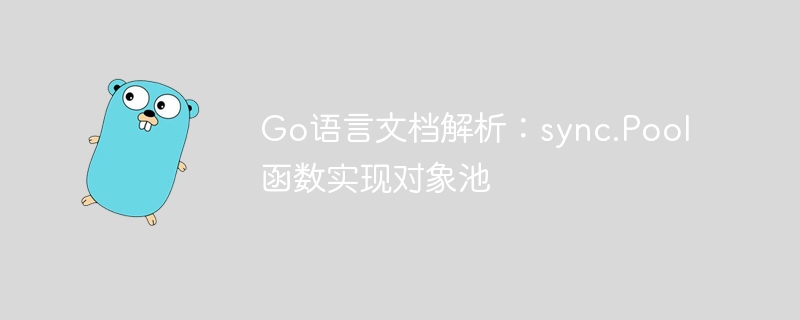Home >Backend Development >Golang >Go language document analysis: sync.Pool function implements object pool
Go language document analysis: sync.Pool function implements object pool
- WBOYWBOYWBOYWBOYWBOYWBOYWBOYWBOYWBOYWBOYWBOYWBOYWBOriginal
- 2023-11-03 16:26:031054browse

Go language document analysis: The sync.Pool function implements the object pool and requires specific code examples
Introduction
In the Go language, memory allocation and Garbage collection is done automatically, which makes the Go language very performant. However, in some cases, frequent creation and destruction of objects may cause performance degradation. In order to solve this problem, the Go language provides the Pool type in the sync package to implement the object pool function. This article will introduce how to use the sync.Pool function and provide code examples.
Introduction to sync.Pool function
sync.Pool is a safe concurrent object pool that can store and reuse temporary objects, thereby reducing the frequent creation and destruction of objects. The Pool type is defined as follows:
type Pool struct {
// 内部字段省略
}
// New函数用于创建一个新的Pool对象
func New(fn func() interface{}) *PoolThere are no public fields inside Pool, so we only need to focus on the use of the New function.
The New function accepts a parameterless function fn as a parameter, which is used to return a new temporary object. The fn function is called when needed to create new objects. There are two ways to create an object function:
- Use the closure method to pass it in the New function.
- Use objects that implement the func() interface{} interface.
Basic usage of sync.Pool
The following is the basic usage of sync.Pool:
- Create an object pool.
var objectPool = sync.Pool{
New: func() interface{} {
return new(Object)
},
}- Get objects from the object pool.
func getObject() *Object {
obj := objectPool.Get().(*Object)
return obj
}- Put the object back into the object pool.
func putObject(obj *Object) {
objectPool.Put(obj)
}It should be noted that before placing the object back into the object pool, we should ensure that the object has been completely reset to its initial state to avoid potential logic errors.
Complete code example
The following is a complete example code that shows how to use sync.Pool to implement an object pool:
package main
import (
"fmt"
"sync"
)
type Object struct {
// 对象的字段
}
var objectPool = sync.Pool{
New: func() interface{} {
return new(Object)
},
}
func getObject() *Object {
obj := objectPool.Get().(*Object)
return obj
}
func putObject(obj *Object) {
objectPool.Put(obj)
}
func main() {
obj := getObject()
defer putObject(obj)
// 使用对象
fmt.Println("成功从对象池中获取了对象")
}Through this example, we can see the object Basic usage of the pool. When we get an object from the object pool, the object pool will first try to take out an existing object. If it does not exist, the New function will be called to create a new object. When we no longer need an object, we can put it back into the object pool for future reuse. This can reduce frequent object creation and destruction and improve performance.
Conclusion
In this article, we have learned the basic usage of the sync.Pool function and provided corresponding code examples. By using sync.Pool to implement object pools, we can reduce the overhead caused by object creation and destruction, thereby improving the performance of Go language programs. When using the object pool, we should pay attention to ensuring the correctness of the object state and putting the object back into the object pool when it is no longer needed.
I hope this article will help you understand the use of sync.Pool function!
The above is the detailed content of Go language document analysis: sync.Pool function implements object pool. For more information, please follow other related articles on the PHP Chinese website!

